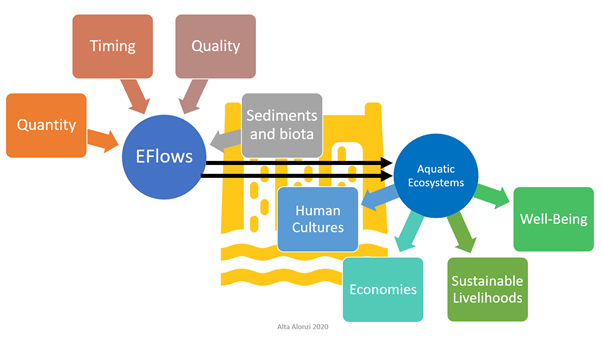Exploring Hydrological Methods for Sustainable River Management
Department of Energy Development (DoED) Nepal Guideline
In accordance with the Guidelines for the Study of Hydropower Projects 2018, the DoED specifies that a compensation flow (10% of the lowest monthly flow or the amount recommended by IEE/EIA study) should be released downstream. This should be deducted from the available dry season flows for the computation of energy estimates.
The government of Nepal plans to harness 10,000 MW by 2026 through various projects. To achieve this goal, it is essential to utilize numerous rivers across Nepal, considering environmental considerations and potential impacts. Determining an appropriate environmental flow figure is a challenge, and studies such as those conducted by Suwal et.al (2020) highlight the need for various indicators of hydrological methods to capture the dynamic nature of river flow in e-flows allocation.Lets discuss some hydrological methods.

Tennant Method for Environmental Flow Assessment
The Tennant Method, also known as the Environment Flow Assessment (EFA), plays a crucial role in preserving aquatic species, protecting fish biology, maintaining habitat diversity, and safeguarding socio-economic aspects. Originating in 1975, Donald Tennant conducted a comprehensive study across 11 streams in Wyoming, Montana, and Nebraska. Based on 58 cross-sections and 38 different flows, Tennant suggested that maintaining a certain proportion of mean annual flow is essential for a healthy stream environment.
Tennant Method Parameters
Tennant identified specific flow conditions and regimes that should be maintained for optimal aquatic life quality. These include:
Short Term Survival
- Average Depth: 0.3m
- Velocity: 0.25m/s
Optimal for Fish
- Average Depth: 0.45 to 0.6m
- Velocity: 0.45 to 0.6m/s
Tennant Method Flow Allocation Table
| Months | October-March | April-September |
|---|---|---|
| Flushing or Max | 200% | 200% |
| Optimum Range | 60-100% | 60-100% |
| Outstanding | 40% | 60% |
| Excellent | 30% | 50% |
| Good | 20% | 40% |
| Fair or Degrading | 10% | 30% |
| Poor or Minimum | 10% | 10% |
| Severe Degradation | 0-10% | 0-10% |
Advantages and Disadvantages
Advantages:
- Easy implementation, requiring no field work.
- Based on a single hydrologic statistic (MAD), which is easy to obtain.
Disadvantages:
- Only applicable for similar geographical regions, similar flow patterns, and hydrologically similar regimes.
- Applicable for low gradient streams only.
- Ignores seasonal and monthly changes, assuming Environment Flow (EF) remains constant.
- Relies heavily on professional judgment and lacks biological validation.
Modified Tennant Method
Recognizing the limitations of the Tennant Method, several modifications have been proposed by researchers to address diverse regions and other requirements.
Matthews, Bao (1991) - Texas Method:
- Uses median annual discharge (MedAD) instead of MAD, considering the life cycle requirements of fish.
Fraser (1978) - Extension Tennant Method:
- Incorporates seasonal variation by specifying minimum flows for each month as a percentage of mean monthly flows.
Tessman (1980):
- Determines flow thresholds by considering natural variations on a monthly basis.
- Introduces a 14-day period of 200% MAF during the month of the highest flow for channel maintenance.
Khatar, Shokoohi (2003):
- Divides the FDC curve for each month into four quadrants to determine the state of the flow regime.
British Columbia (BC) - Instream Flow Thresholds
Developed by Hatfield et al. (2003), the BC method is another hydrological approach based on historical data. It incorporates biological and physical information, allowing regionalization based on fish life history and ecological needs.
| Biological or Physical Requirement | % MAD | Duration per annum |
|---|---|---|
| Short-term biological maintenance | 10 | Days |
| Juvenile summer to fall rearing | 20 | Months |
| Over-wintering | 20 | Months |
| Riffle optimization | 20 | Months |
| Incubation. | 20 | Months |
| Kokanee spawning | 20 | Days-weeks |
| Smolt emigration | 50 | Weeks |
| Gamefish passage at partial barriers | 50-100 | Days |
| Large fish spawning/migration | 148MAD^0.36 | days-weeks |
| Off-channel connectivity/riparian function | 100 | Weeks |
| Channel geomorphology/sediment flushing | >400 | 1 to 2 days |